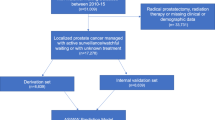Abstract
Active surveillance (AS) is an alternative to total prostatectomy (TP) in managing low-risk prostate cancer (PC). Our aim is to compare urologist reimbursement for managing low-risk PC by AS or TP. The urologist's reimbursement for TP includes the fee for the procedure and follow-up visits. For AS, our protocol involves digital rectal examination (DRE) and PSA testing every 3 months for first 2 years and every 6 months thereafter. Transrectal ultrasound (TRUS)-guided biopsies are performed yearly. Some urologists recommend spacing the biopsies by 1–3 years. Medicare reimbursement values were used. The urologist reimbursements for a follow-up visit, prostate biopsy, open TP and robotic TP are $72, $595, $1905 and $2939, respectively. We also corrected for a 15% chance of having TP after being on AS. The cumulative reimbursements from open TP and following the patient up to 10 years are approximately $2121 (1 year), $2265 (2 years), $2697 (5 years) and $3057 (10 years). For robotic TP, the urologist reimbursements are $3155 (1 year), $3259 (2 years), $3731 (5 years) and $4091 (10 years). For AS, the urologist reimbursements are $883 (1 year), $1766 (2 years), $4269 (5 years) and $7964 (10 years). The urologist reimbursement from AS and TP become nearly equal between 3 and 4 years follow-up, subsequently AS attains higher reimbursement.
This is a preview of subscription content, access via your institution
Access options
Subscribe to this journal
Receive 4 print issues and online access
$259.00 per year
only $64.75 per issue
Buy this article
- Purchase on Springer Link
- Instant access to full article PDF
Prices may be subject to local taxes which are calculated during checkout


Similar content being viewed by others
References
Jemal A, Siegel R, Ward E, Hao Y, Xu J, Thun MJ . Cancer statistics, 2009. CA Cancer J Clin 2009; 59: 225–249.
Cooperberg MR, Moul JW, Carroll PR . The changing face of prostate cancer. J Clin Oncol 2005; 23: 8146–8151.
Klotz L . Active surveillance for prostate cancer: trials and tribulations. World J Urol 2008; 26: 437–442.
Zietman A . Active surveillance: a safe, low-cost prognostic test for prostate cancer. BJU Int 2008; 101: 1059–1060.
Soloway MS, Soloway CT, Williams S, Ayyathurai R, Kava B, Manoharan M . Active surveillance; a reasonable management alternative for patients with prostate cancer: the Miami experience. BJU Int 2008; 101: 165–169.
Gatling RR . Prostate carcinoma: an autopsy evaluation of the influence of age, tumor grade, and therapy on tumor biology. South Med J 1990; 83: 782–784.
Dall’era MA, Carroll PR . Outcomes and follow-up strategies for patients on active surveillance. Curr Opin Urol 2009; 19: 258–262.
Watanabe M, Nakayama T, Shiraishi T, Stemmermann GN, Yatani R . Comparative studies of prostate cancer in Japan versus the United States. A review. Urol Oncol 2000; 5: 274–283.
Drouin SJ, Roupret M . News aspects on surgical management of localized prostate cancer. Prog Urol 2009; 19 (Suppl 1): S12–S14.
Eggener SE, Mueller A, Berglund RK, Ayyathurai R, Soloway C, Soloway MS et al. A multi-institutional evaluation of active surveillance for low risk prostate cancer. J Urol 2009; 181: 1635–1641.
Bodenheimer T . High and rising health care costs. Part 1: seeking an explanation. Ann Intern Med 2005; 142: 847–854.
Dorman T . Unsustainable growth rate: physician perspective. Crit Care Med 2006; 34 (Suppl 3): S78–S81.
Lotan Y, Cadeddu JA, Roehrborn CG, Stage KH . The value of your time: evaluation of effects of changes in medicare reimbursement rates on the practice of urology. J Urol 2004; 172 (5 Pt 1): 1958–1962.
Adiga K, Buss M, Beasley BW . Perceived, actual, and desired knowledge regarding Medicare billing and reimbursement. A national needs assessment survey of internal medicine residents. J Gen Intern Med 2006; 21: 466–470.
Madan AK, Tichansky DS, Barton GE, Taddeucci RJ . Knowledge and opinions regarding Medicare reimbursement for laparoscopic cholecystectomy. Surg Endosc 2007; 21: 2091–2093.
Thompson I, Thrasher JB, Aus G, Burnett AL, Canby-Hagino ED, Cookson MS et al. Guideline for the management of clinically localized prostate cancer: 2007 update. J Urol 2007; 177: 2106–2131.
Mohler J, Bahnson RR, Boston B, Busby JE, D’Amico A, Eastham JA et al. NCCN clinical practice guidelines in oncology: prostate cancer. J Natl Compr Canc Netw 2010; 8: 162–200.
Acknowledgements
This study was supported by ‘CURED’ and Vincent A Rodriguez.
Author information
Authors and Affiliations
Corresponding author
Ethics declarations
Competing interests
The authors declare no conflict of interest.
Rights and permissions
About this article
Cite this article
Manoharan, M., Eldefrawy, A., Katkoori, D. et al. Comparison of urologist reimbursement for managing patients with low-risk prostate cancer by active surveillance versus total prostatectomy. Prostate Cancer Prostatic Dis 13, 307–310 (2010). https://doi.org/10.1038/pcan.2010.34
Received:
Revised:
Accepted:
Published:
Issue Date:
DOI: https://doi.org/10.1038/pcan.2010.34
Keywords
This article is cited by
-
Costs of conservative management of early-stage prostate cancer compared to radical prostatectomy–a claims data analysis
BMC Health Services Research (2016)



